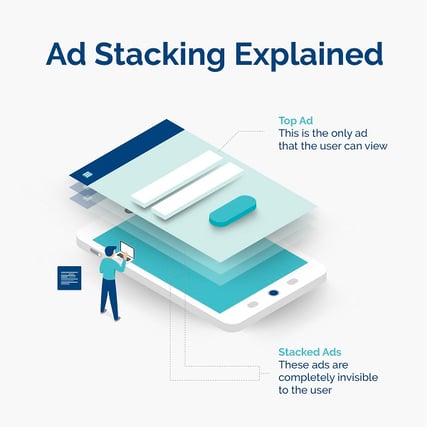What is Ad Stacking and How to Prevent it

 By
Eduardo Aznar
·
3 minute read
By
Eduardo Aznar
·
3 minute read
Even for those in the digital advertising industry, ad fraud is a tough topic to discuss and define. We all know it’s happening, but the various methods of ad fraud and their impacts are hard to pin down, which makes it even more difficult to know how to prevent them.
Ad stacking, however, is one of the more common types of mobile ad fraud that plague cost-per-mille (CPM) and pay-per-click (PPC) campaigns, amongst others. Despite how prevalent it is, the good news for advertisers is that it’s a relatively easy tactic to detect.
Here, we’ll go through how ad stacking works, the threats it poses to your organization, and the solutions you need to put in place to counteract it.
How does ad stacking work?

Ad stacking is just that: multiple ads stacked one on top of the other. This occurs when fraudsters literally layer ads on top of each other in the same ad placement, yet only the ad on top is visible to the user.
Despite the user only seeing the one ad on top, advertisers end up paying for all the false ad impressions and clicks gleaned from the ads beneath. Advertisers are still charged for unseen or unclicked ads since they still load correctly, and meet the requirement of having one pixel shown for at least half a second (a common metric in the digital advertising industry).
The purpose of this activity is to charge publishers and advertisers for the impressions and clicks received by all of the stacked apps.
What are the threats posed by ad stacking?
Ad stacking is an easy method of ad fraud to execute, but its effects are far-reaching. Let’s take a close look at some of the impacts ad stacking has on organizations.
Exhausted budgets
The fake impressions and clicks caused by ad stacking result in advertisers being wrongfully charged, meaning that advertisers’ budgets deplete rapidly, and without any benefit to show for it.
Many fraudsters also employ the use of bad bots to increase views or clicks on ads, which speeds up the depletion of budgets even more.
Skewed campaign data
One of the most destructive impacts of ad stacking is the skewed campaign data that results from it.
Any impressions or clicks received when ads are stacked results in incorrect campaign data. For example, if your ad generates 20,000+ impressions but very few of those impressions produce conversions, you’d likely be quick to assume that the nature of the ad was to blame.
In reality, the ad content was great, and your conversion rate was actually pretty reasonable -- yet, you feel compelled to create a new ad to replace the “ineffective” one due to misleading data created by ad stacking fraud.
This leaves you completely unaware of how effective your ad campaigns are, and can have devastating knock-on effects on campaign strategies and workloads since the data you’re working with is not data-driven, but fraud-driven.
What can you do to identify and prevent ad stacking?

Since ad stacking is one of the easiest ways to carry out ad fraud, organizations continue to fall victim to it and pay a high price. Additionally, as fraudsters attack multiple individual organizations, it’s up to the organizations themselves to implement a solution that prevents them.
Here are a few ways you can identify whether your organization has been targeted by ad stacking:
- Regularly check your campaign backend. If you’re running multiple campaigns, you’ll be able to identify the same device clicking on multiple ads with the same timestamp.
- Regularly monitor your campaign conversion rates. High impressions counts with low conversion rates are a tell-tale sign of ad stacking practices.
- Check-in with your ad platform or publisher: If you’re not convinced your campaign is having any effect, ask your ad platform or publishers to investigate.
However, the only way to stop ad stacking at the source is with an anti-fraud solution. Since these tools are able to automatically detect illegitimate traffic and devious actors, you don’t need to wait until ad stacking has eaten into your budget before taking action.
Manual traffic quality checks are time-consuming and costly, yet anti-fraud solutions can help you automatically blacklist site and device IDs, filter traffic sources for different campaigns, and reveal true user data to help augment and improve your campaigns.
Don’t let the ads be stacked against you
Fraudsters easily siphon huge amounts of money from advertisers’ pockets every day. It’s easy for them to carry out on a large-scale basis, but has devastating effects on your budgets and efforts.
It’s time for you to make fraudsters’ lives difficult by implementing a robust anti-fraud solution that can easily filter out their misdeeds without you needing to intervene. To receive a free consultation on how the expert team at Opticks can help protect your advertising campaigns, contact our team here.